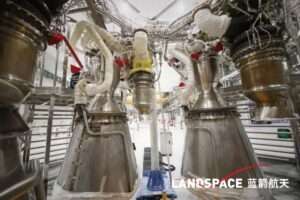Landspace closes in on orbital launch with liquid methane rocket
By Andrew Jones

HELSINKI — Chinese private firm Landspace is working towards a potential first orbital launch attempt with a methane-fueled launch vehicle later this year.
Landspace completed assembly of the four Tianque-12 liquid methane-liquid oxygen engines which power the first stage of the Zhuque-2 rocket in early February.
This was preceded by a payload fairing separation test and a series of 400-second hotfire tests of the 80-metric-ton thrust engines in late January.
The 49.5-meter-tall, two-stage Zhuque-2 could be the first methane-fueled rocket to launch for orbit. Blue Origin’s New Glenn and ULA’s Vulcan—both powered by the former’s BE-4 staged-combustion methalox engines—are also aiming for debut launches in 2021.
Zhuque-2 is powered by less complex yet less efficient gas generator engines. The launcher will be capable of delivering a 4,000-kilogram payload capacity to a 200-kilometer LEO. Alternatively ZQ-2 can loft 2,000 kilograms to 500-kilometer SSO, according to Landspace.
A target date for the launch attempt has not been revealed by Landspace but is expected during 2021.
The first launch will be expendable, but Landspace is working on technologies including pintle injectors in order to develop a variant thrust version of the Tianque-12 to allow vertical takeoff, vertical landing and thus recover and recycle first stages.
Zhuque-2 could also be the first launch attempt with a liquid propellant rocket developed by a Chinese commercial launch provider, a notable step in complexity and capabilities.
All of the five orbital launch attempts so far by Chinese firms Landspace, OneSpace, iSpace (2) and Galactic Energy have been solid rockets, with three failures.
Competitor iSpace is developing its own reusable Hyperbola-2 methalox launcher, while engine manufacturers Jiuzhou Yunjian and Aerospace Propulsion are developing liquid methane engines for the market.
New launch complex for methalox rockets
China is understood to be constructing a new launch complex in the vicinity of Jiuquan Satellite Launch Center in the Gobi Desert, one of four national launch sites, in order to facilitate launch of new methalox launch vehicles.
Jiuquan currently only handles launches of older, hypergolic Long March rockets and solid rockets, necessitating a new comlex.
Limited details of the complex were laid out in a paper abstract to be presented at the virtual International Astronautical Congress in 2020. The site will provide access to low Earth orbit and Sun-synchronous orbit and have an initial launch capacity of at least 12 times per year.
Range safety, air traffic, the natural and cultural environment and other factors were considered in location selection for the launch complex.
Imagery accessed through the Planet Labs Inc. media program indicates ongoing construction near Jiuquan. New facilities are also likely being built to support launches of new solid Kuaizhou rockets.
A new complex for methalox launchers at Jiuquan? Satellite imagery indicating construction activities in the vicinty of Jiuquan Satellite Launch Center from H2 2020 to early 2021. Credit: Planet Labs Inc. pic.twitter.com/wk4zRIrzUA
— Andrew Jones (@AJ_FI) February 19, 2021
The China National Space Administration stated in 2018 that the construction of an open and shared commercial space launch site was being explored (Chinese). The move follows a range of policies designed to facilitate and support China’s emerging commercial space sector.
China is additionally constructing a new spaceport in Haiyang City on the coast of Shandong province to boost orbital launch capacity. The spaceport will facilitate sea launches of Long March 11 and commercial Jielong rockets as well as development of rockets, satellites and related applications.
Commercial space takeoff in China
Chinese commercial space companies have been established since 2014, following a government policy decision, referred to as ‘Document 60’, to open portions of the space sector to private capital.
China’s commercial space sector has been supported by the military-civilian fusion national strategy, allowing production of sensitive, dual-use technologies to take place in the private sector. Overall objectives include integrating civilian and defense sectors to enhance innovation and the development of emerging capabilities, especially those not suited to development by giant state-owned enterprises (SOEs).
Many of the companies have been founded by former employees of SOEs, especially the China Aerospace Science and Technology Corp. (CASC) and the China Aerospace Science and Industry Corp. (CASIC), as well as the Chinese Academy of Sciences (CAS).
While firms are raising funds—Landspace raised $175 million in a funding round last September—the nature of and distance of the commercial and private companies from these SOEs is somewhat blurred. There are also entities such as China Rocket, Expace and CAS Space which are direct spinoffs from the above respective SOEs.
Further specific policies supporting and guiding the commercial space sector have also been issued. Meanwhile the China’s National Development and Reform Commission’s (NDRC) decision in April to add ‘satellite internet’ to a list of “new infrastructures” sparked a flurry of funding activity in the weeks following.
Local governments are also seeking to attract new space industry players for the potential gains from cross-fertilization innovation and spinoff technologies.
February 19, 2021 at 07:22PM
via SpaceNews read more...

Post a Comment